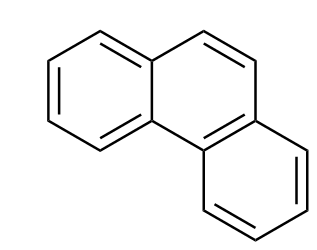Polycyclic Aromatics
( \newcommand{\kernel}{\mathrm{null}\,}\)
Polycyclic aromatics are compounds containing two or more fused aromatic rings. These fused benzene rings share two carbon atoms between them. These are also called polycyclic benoid or polycyclic aromatic hydrocarbons (PAHs). Many PAHs are carcinogenic and highly toxic.
Naming
The naming system for PAHs is quite complex. A series of fused benzene rings that occur in a linear manner are called acenes.


Anthracene Tetracene
Another form of fusion of benzene rings is angular fusion, or "annulation", which is, as its name implies, an angled fusion of the benzene rings.

Figure 1: Phenanthrene
Naphthalene
.png?revision=1&size=bestfit&width=260&height=121)
Figure 2: Naphthalene
Naphthalene is the simplest polycyclic aromatic hydrocarbon since it is only a bicyclic molecule made up of two aromatic benzenes. The pi electrons in this molecule are even more delocalized than those in the simpler benzene molecule. Naphthalene is also planar and has 4n + 2 pi electrons (10) giving it the stabilizing and resonating aromatic properties shared with benzene.
Most Fused Benzenoid Hydrocarbons are aromatic
Aromaticity is a property that the majority of fused benzenoid hydrocarbons share. The extent to which each polycyclic molecule is aromatic varies. As shown above, the structural isomers of anthracene and phenanthrene are very similar molecules made up of three benzene rings. Anthracene is fused linearly, whereas phenanthrene is fused at an angle. This difference in fusions causes the phenanthrene to have five resonance structures which is one more than anthracene. This extra resonance makes the phenanthrene around 6 kcal per mol more stable.
References
- Vollhardt, Peter, and Neil Shore. Organic Chemistry: Structure and Function. 5th. New York: W.H. Freeman and Company, 2007.
- Daley, Richard, and Sally Daley. "17.10 Polynuclear Aromatic Hydrocarbons." Organic Chemistry. Daley. 5 July 2005. 26 Feb. 2009.

